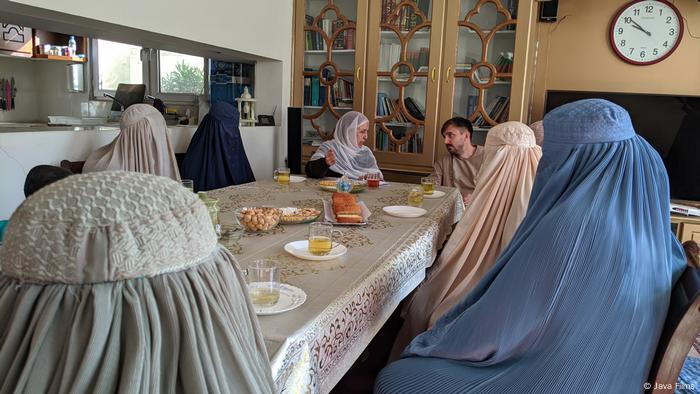The timely film, which portrays divisions in Afghan society, as well as the government's false claims, was screened at the Human Rights Film Festival Berlin.

Searching for traces of the ghosts of Afghanistan: Canadian journalist Graeme Smith in a Kandahar graveyard
The documentary Ghosts of Afghanistan, shown at the Human Rights Film Festival Berlin, follows Canadian war correspondent Graeme Smith as he returns to Afghanistan and visits various people who were involved in rebuilding the country or who can offer an insider's perspective on the social and political context.
The deep divisions in Afghanistan are particularly evident through the perspective of the different women interviewed in the film. Among them is Shaharzad Akbar, the country's top human rights investigator, who denounces abuse by both the Taliban and the government.
Smith also meets outspoken students from Kabul University who discuss how the Taliban may threaten their hard-won rights and liberties.
A particularly striking contrast is revealed through one meeting with a group of burqa-clad women in Kandahar who live in compliance with the Taliban's expectations, as opposed to another person interviewed, Farahnaz Forotan, who is one of the country's most outspoken feminists.
Her home, decorated with large Frida Kahlo self-portraits revealing her breasts, would shock many conservatives.

Provocative art in an Afghan woman's office: Feminist Farahnaz Forotan is featured in "Ghosts of Afghanistan"
Hindsight revelations
Current developments in Afghanistan make the film very timely, but, as it was filmed in 2019, it provides background on the structures that allowed the Taliban to retake Afghanistan.
As Smith explained at the Berlin festival, the initial version of the film offered an ending that was hopeful about a political settlement: "We didn't expect the Taliban to make a full military takeover of the country, so it involved very-last-minute edits," he said. "We had hoped that the process in Doha could lead to a compromise between the Taliban and their enemies."

In the film, these women say they do not feel threatened by the Taliban
The hindsight provided by the documentary is particularly revealing. Director Julian Sher told DW: "A major point of our movie is that the Taliban is much, much stronger than the Afghan government or the Western armies were willing to admit."
Warnings about the Taliban were dismissed
Two interviews in the film express this idea particularly well. In one scene, Rahmatullah Amiri, one of Afghanistan's most respected political analysts, warns that in 2019 the Taliban had a major part of the country "under their full control."
That statement is followed by an optimistic claim by National Security Adviser Hamdullah Mohib, who says: "We have broken the back of the Taliban." He adds: "We have a military path to victory in this conflict."
"That's not true at all," is Amiri's reaction to the information. "If the back of the Taliban could be broken, that would be from 2009 to 2014, where hundreds of thousands of international troops where there and billions of dollars were poured into the construction and nation-building and everything." Amiri goes on to correctly predict that the Taliban "haven't reached their peak yet."
Broken trust
Many people were inclined to believe and put their hopes in the country's 38-year-old Western-educated national security adviser, Hamdullah Mohib, who had served as the former Afghan ambassador to the US and was seen as one of the most trusted aides of President Ashraf Ghani. They both fled the country on August 15.

National security adviser Hamdullah Mohib being interviewed by Smith in "Ghosts of Afghanistan"
Afghan journalist Khwaga Ghani, who worked as a fixer on Ghosts of Afghanistan, was among those who were deeply disappointed by Mohib, a figure she had found particularly inspiring during the filming of the documentary in 2019.
"I had a totally different perspective and idea on what he was going to do for the country. I thought he could bring changes in society, in the security situation," she told DW. "But at the end, he really broke not just my trust but everybody's trust."
Leaving Afghanistan
Like many others, Khwaga Ghani was forced to leave Afghanistan after the Taliban took over. As she was also working for different media outlets, including The New York Times, NPR, Vice and National Geographic, she managed to escape Kabul with her family thanks to the intervention of her US colleagues.
It was a complicated process. After four days spent hiding at a hotel after the Taliban's takeover of Kabul, her family was escorted to the airport. Ghani said they had to spend two nights close to the runway before being admitted into a plane that was filled with more than 400 people.
Their first stop was in Qatar, where they spent seven hours stuck in the plane, waiting for the buses that would take them to the military base. "Children were fainting inside the plane, there was no oxygen," she said.
Confronting the ghosts
After a second halt at the US airbase in Ramstein, Germany, they were finally sent to the Fort McCoy base in Wisconsin, where they are still waiting. Even though Ghani has contacts in the area, she is not allowed to leave the US army installation, where they have been kept for 21 days already. They do not exactly know when they will be allowed to leave, as investigations into the different refugees have to be completed.
Ghani and her family plan to eventually go to California, where her brother is already living. She has been granted a scholarship to pursue her studies in journalism and human rights.
Like many other Afghans, she intends to confront the ghosts of Afghanistan in the future. "I hope for my country to get better, so I can go back," she said. Meanwhile, she added, "I want to learn things here that will help bring some changes in my country."
No comments:
Post a Comment